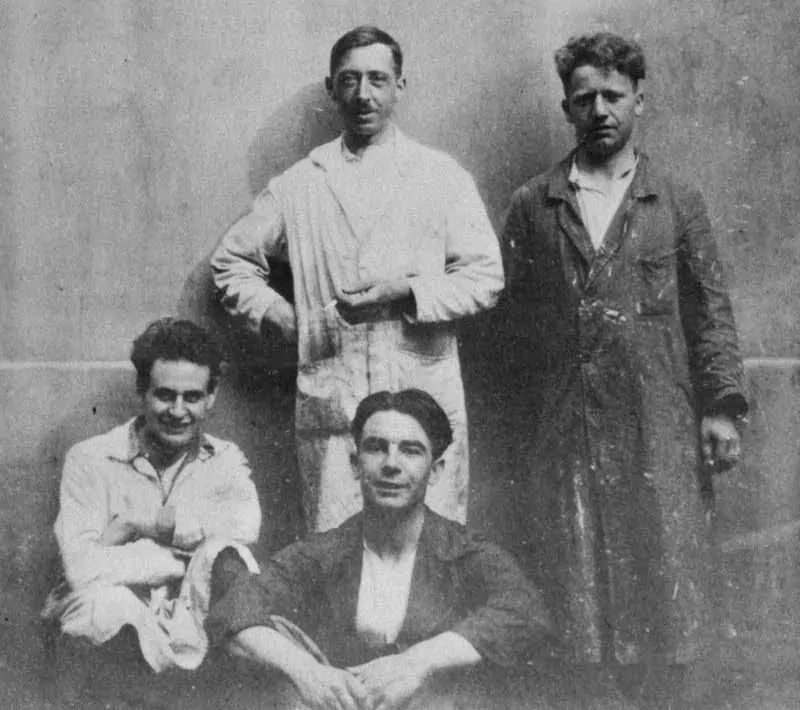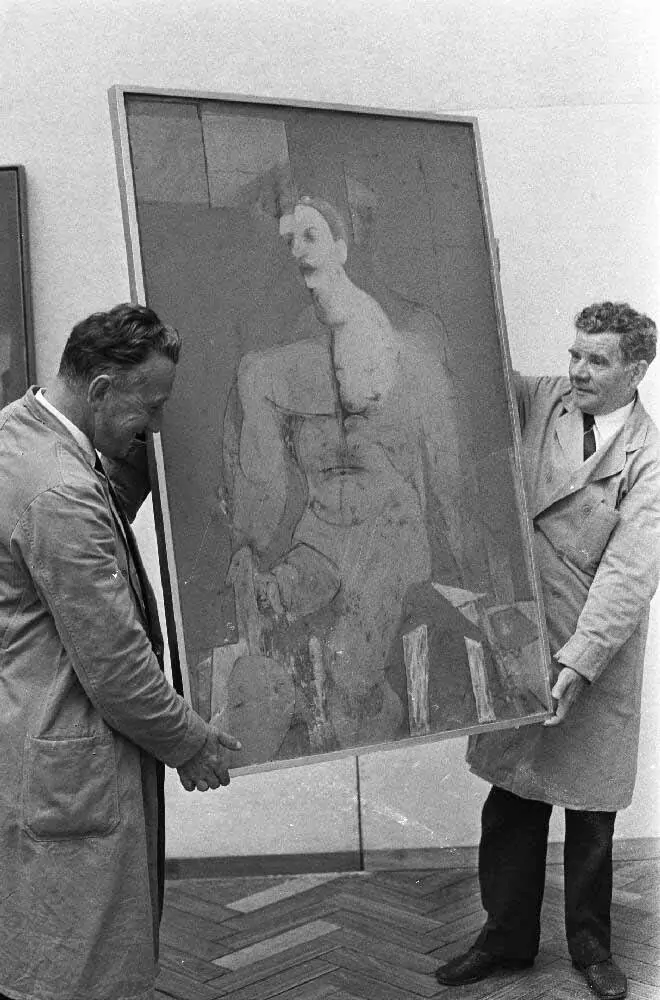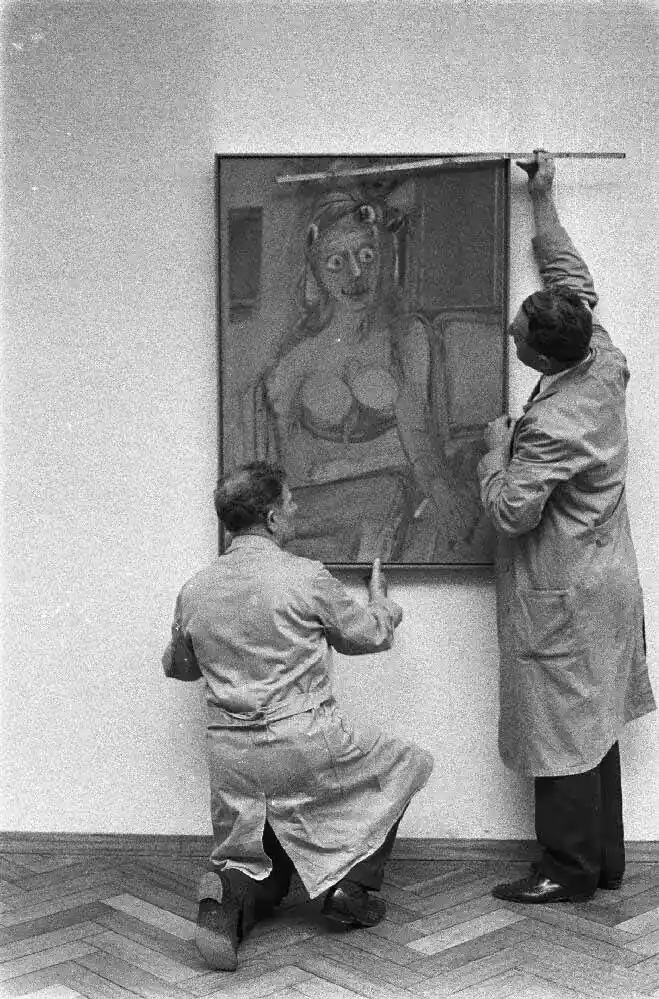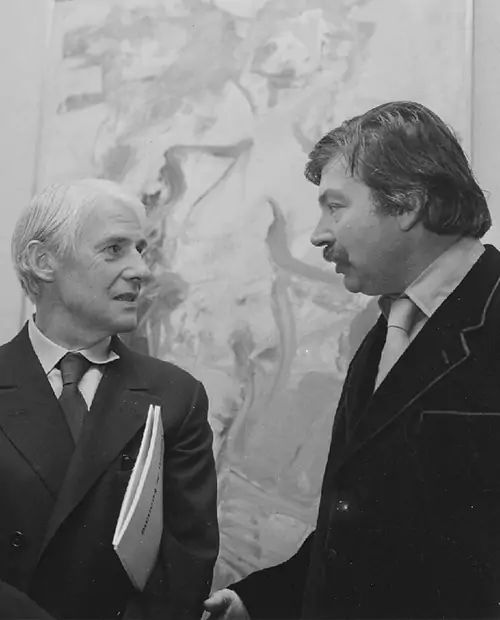De Kooning Info

de Kooning with painting, 1946. Photograph by Harry Bowden, 10x9in. Archives of American Art.
1904 April 24, Willem de Kooning is born in Port of Rotterdam, Holland, to Leendert de Kooning (b. February 10, 1876) and Cornelia Nobel de Kooning (b. March 3, 1877). He has one older sister, Marie (b. 1899). (His mother later gives birth to three more daughters, none of whom live past one year.)
1909 Parents divorce; court awards custody of five-year-old Willem to his father. His mother, however, kidnaps Willem and is later awarded full custody.
1916-1920 Begins training in commercial art under Jan and Jaap Giding, proprietors of a large commercial art firm, with whom he resides. Enrolls in the Academie voor Beeldende Kunsten en Technische Wetenschappen in Brussels, Belgium, attending night classes until 1924, when he graduates with certifications in both carpentry and art.
1920 Leaves the Giddings to begin training with Bernard Romein, noted art director of a large department store in Rotterdam.
1916 Completes grammar school.
1920 Leaves the Giddings to begin training with Bernard Romein, noted art director of a large department store in Rotterdam.
1924-1926 Travels to Antwerp and enrolls in the Van Schelling School of Design, commuting to Brussels to study simultaneously at the Académie Royale des Beaux-Arts, supporting himself with commercial work.

de Kooning with painting, 1946. Photograph by Harry Bowden, 10x9in. Archives of American Art.
1926 Immigrates to United States as a stow-away on the SS Shelly, arriving in Newport News, Virginia on July 30. Takes ship to Boston, Massachusetts, then travels by train to Rhode Island. Settles in Hoboken, New Jersey, and finds lodging at the Dutch Seaman’s Home. Becomes acquainted with other artists and moves to New York City. Works as commercial artist and as a sign-painter, window dresser, and carpenter.
1927 Moves to Manhattan and begins working for Eastman Brothers, a design firm. Meets Misha Reznikoff, who is later instrumental in securing his 1948 summer teaching job at Black Mountain College.
1928 Spends the summer at the artists’ colony in Woodstock, New York.
1929 Becomes associated with modern artists John Graham and Stuart Davis. Buys Capehart hi-fi sound system, spending nearly six months’ salary. Frequents George’s in the Village and the Savoy Ballroom in Harlem with David Margoli and other artists.
1930 Meets David Smith and Arshile Gorky. Moves into studio apartment with Gorky. Works as a window dresser for A.S. Beck, a chain of shoe stores in New York. Meets Virginia “Nini” Diaz, with whom he goes to Woodstock, New York. in late May. Moves to 348 W. 55th Street with Diaz in the autumn; Diaz’s mother moves in. Diaz has first of three abortions, the last in 1935, which leaves her unable to conceive.
1932 Moves to Greenwich Village with Diaz.
1934 Joins Artist’s Union, which leads to attending John Reed Club (a pro- Communist group) meetings, despite his anti-Commuist leanings. Meets Julie Browner in May and begins relationship; Diaz moves out. Returns to Woodstock and rents home with Browner for the summer. Invites Diaz to join them, which she does, resulting in a ménage à trois. Invites Marie Marchowski and her friend to join them; they also move in. Returns to New York City, live at 40 Union Square, a home owned by friend and architect Mac Vogel. Browning returns from Woodstock; she and de Kooning move to 145 West 21st Street, then to 145 West 23rd Street.
1935 Meets Rudy Burckhardt and Edwin Denby, who become first collectors of de Kooning’s work. Begins full-time employment with the mural division of the Works Progress Administration’s Federal Art Project, one of which is the Williamsburg Federal Housing Project in Brooklyn. Makes pivotal decision to devote his life to art, inspired by WPA director Burgoyne Diller. Leaves A.S. Beck to pursue art full time. Meets art critic, Harold Rosenberg. His mother comes to visit.
1936 Moves with Browner to commercially-zoned 156 West 22nd Street. Meets artist Mark Rothko. Unfinished work for the Williamsburg mural is included in group exhibition New Horizons in American Art at the Museum of Modern Art in Manhattan, September 14-October 12; this is his first public recognition in America. Declines participation in the American Abstract Artists group.
1937 System and Dialectics of Art, by John Graham, is published, naming de Kooning one of eight painters he considered “outstanding.” Arshile Gorky paints Portrait of Master Bill, a painting of de Kooning. Resigns from the WPA in August when “American citizens only” policy is announced, effective post-July. Begins work on a mural, Medicine, for the World’s Fair on the Hall of Pharmacy building; work on this continues until early 1939.
1938 Browner moves in with Diaz. Meets Elaine Marie Fried, a fellow artist and teacher. Paints a series of male figures, including Two Men Standing, A Man, and Seated Figure. Begins abstractions Pink Landscape and Elegy.
1939 Becomes influenced by the Surrealist style of Gorky and Picasso and the Gestural style of Jackson Pollock and Franz Kline. Suffers financially; tutors local art students. Becomes engaged to Fried. Visits Balcomb Greene in Fishkill. With other artists, petitions the Museum of Modern Art to show the work of Earl Kerkam after his death.

de Kooning with painting, 1946. Photograph by Harry Bowden, 10x9in. Archives of American Art.
1940 Alcoholism and poverty are both significant. Becomes identified with the Abstract Expressionist movement. Drawings appear in Harper’s Bazaar. On May 14, his birthplace, Rotterdam, is hit by Germans. Harper’s Bazaar commissions four hairstyle sketches, with Elaine as model, for $75 each.
1941 Attends Miro exhibition. Is influenced by Matta, with whom he and Gorky become friends.
1942 Work is featured in the January 20-February 6 John Graham exhibition at McMillan, Inc. Drawing of a sailor with pipe is used in advertisement for Model Tobacco in Life Magazine.
1943 George Keller promises a one-man show at his Bignou Gallery; de Kooning fails to send sufficient work to exhibit. A group show included Pink Landscape and Elegy; both were bought by Helena Rubenstein for $1,050. Moved to 156 West 22nd Street. In summer, meets Franz Kline at Conrad Marca Relli’s 148 West 4th Street studio. Marries Elaine Fried on December 9. Shortly thereafter, he discovers her in bed with ex-lover, Robert Jonas.
1944 Abstract and Surrealist Art in the United States features de Kooning’s work at the Cincinnati Art Museum, February 8 – March 12. After closing, the exhibition moves to the Mortimer Brandt Gallery. Sidney Janis publishes the book, Abstract and Surrealist Art in America.
1945 Painting The Netherlands wins competition sponsored by the Container Corporation of America in January. The Wave is shown in the Autumn Salon at Peggy Guggenheim’s Art of This Century exhibition in the fall. Elaine sails to Provincetown with physicist Bill Hardy; de Kooning disapproves. Paints Pink Angels.
1946 Inspired by Pollock and Kline, begins first black-and-white abstracts. Charles Egan opens gallery at 63 East 57th Street. Marie Marchowsky commissions backdrop for a dance performance at New York Times Hall; de Kooning and Resnick collaborate on the project. Rents a studio with Jack Tworkov. Contacts father by letter in November requesting to see him. His father encourages him to seek more stable employment.

de Kooning with painting, 1946. Photograph by Harry Bowden, 10x9in. Archives of American Art.
1947 Creates the black-and-white painting, Orestes, entitled by Tiger’s Eye magazine.
1948 Charles Egan Gallery arranges first one-man show on April 12, consisting of black-and-white enamels including Painting, Village, Square & Dark Pond; reviews are favorable. Museum of Modern Art purchases Painting for $700; it is the only sale of the exhibition. Teaches summer session at Black Mountain College in North Carolina. Returns with student Pat Passlof.. Arshile Gorky hangs himself July 21. Elaine has affairs with Charles Egan, a brief fling with Harold Rosenburg, and then an affair withThomas Hess; the latter relationship lasts until the early 1950s. Willem has numerous trysts and involvements.Mailbox is shown at the Whitney’s annual show of American art the fall. Life magazine names de Kooning one of the five “young extremists.”
1949 Meets Mary Abbott; begins affair which extends intermittently until the mid-1950s. Is introduced to projector by Franz Kline; begins series of large canvas abstractions. Gives first public statement at The Subjects of the Artist School. Drinking increases. Rents cottage with Elaine in Provincetown. Paints Sailcloth and Two Women on a Wharf. Sidney Janis Gallery features portrait of de Kooning with Elaine in exhibition.Intrasubjectives exhibition at Samuel M. Kootz Gallery, September 4 – October 3, includes de Kooning. Opens restaurant, The Club, with other artists.
1950 Begins Woman I; at nearly seven feet in height, it is his largest, completes in 1952. Participates with Alfred Barr in the Venice Biennale exhibition of younger American Painters in the U.S. Pavilion, June 8-October 15. Young Painters in the U.S. and France exhibits Woman (1949-1950) at the Sidney Janis Gallery. Joins symposium which writes letter of protest to New York Herald Tribune regarding the national jury of selection for the Metropolitan Museum of Art; group pickets the Museum and refuses to submit work. New York Herald Tribune calls the group “The Irascible Eighteen.” Protest is covered in numerous national magazines. Teaches at Yale School of Art until 1952. Helps title Franz Kline’s first one-man show.
1951 Excavation is exhibited in Abstract Painting and Sculpture in America at the Museum of Modern Art, January 23 – March 25. Speaks at symposium organized by the Museum of Modern Art. Holds one-man show at Egan Gallery in April, with limited sales and no proceeds after expenses. Participates in Ninth Street Exhibition. Receives financial support from Sidney Janis, contingent upon agreement to call his studio the Janis Gallery. Excavation wins $4,000 first prize in the 60th Annual American Exhibition: Paint and Sculpture at the Art Institute of Chicago. One of 20 artists exhibited in the American Vanguard Art for Paris exhibition at Sidney Janis Gallery, December 26 – January 5, 1952.
1952 Abandons Woman I, but revisits at the urging of art historian Meyer Sharpiro in June; completes in mid-June, but begins reworking in December. Starts several new “Woman” works. Elaine accompanies him to the Hamptons. Moves to 88 East 10th Street; spends much time with Harold Rosenberg. Meets art student Joan Ward, who becomes pregnant; the pregnancy is aborted.
1916 Completes grammar school.
1916-1920 Begins training in commercial art under Jan and Jaap Giding, proprietors of a large commercial art firm, with whom he resides. Enrolls in the Academie voor Beeldende Kunsten en Technische Wetenschappen in Brussels, Belgium, attending night classes until 1924, when he graduates with certifications in both carpentry and art.
1920 Leaves the Giddings to begin training with Bernard Romein, noted art director of a large department store in Rotterdam.
1924-1926 Travels to Antwerp and enrolls in the Van Schelling School of Design, commuting to Brussels to study simultaneously at the Académie Royale des Beaux-Arts, supporting himself with commercial work.